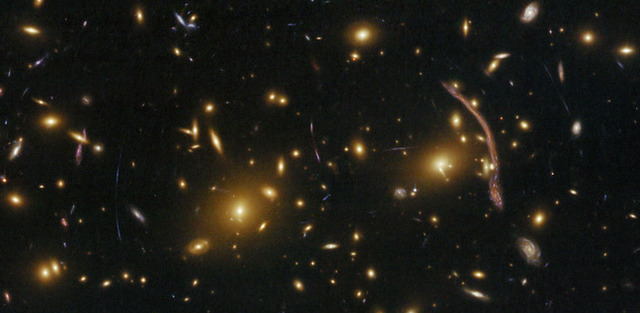
We haven't yet been able to make a lens powerful enough to spot objects on the far edges of the visible Universe. Fortunately, the Universe itself has provided us with some gravitational lenses that might do the trick. Clusters of galaxies contain enough dark matter for their gravity to distort space significantly, curving it in a way that forms a lens and magnifying more distant objects. The Hubble Space Telescope has now been used to peer into a gravitational lens, and may have spotted the oldest, most distant galaxy yet observed.
Because of the expansion of the Universe, light from distant objects is shifted toward the red end of the spectrum. At great distances, one of the spectral lines that is diagnostic of hydrogen shifts from its normal location in the UV all the way down to the infrared. And picking out hydrogen is rather important. Since the most distant objects are also the oldest, the earliest galaxies in our Universe existed before there had been many heavier elements produced by the first generation of stars—the vast majority of the material around was still hydrogen.
To find an early galaxy, a team called CLASH (Cluster Lensing And Supernova survey with Hubble) has been searching for galaxy clusters that create nice gravitational lenses. They found one in MACS J1149.6+2223, which they describe as having "a relatively flat mass distribution profile and a large area of high magnification, making it one of the most powerful cosmic lenses known."
Imaging the lensed area in the infrared revealed something intriguing: an object the authors term MACS1149-JD1. The Hubble's IR camera couldn't detect it at wavelengths shorter than 1.2 mircons (the near-infrared). But it did appear in images taken with the hardware on Hubble that goes deepest into the infrared. To confirm there was something there, the astronomers got time on the Spitzer infrared space telescope and confirmed there really was an object at this location.
Red shift is measured in terms of a value called z, and the shifting of the hydrogen spectral lines suggest that MACS1149-JD1 comes in at a z of 9.6, one of the most distant objects detected. Only one other galaxy has ever been spotted at a similar distance, and only a single gamma ray burst came from anywhere near there. Because redshift is proportional to time, the authors were able to calculate an age: 490 million years after the Big Bang. That's under five percent of the age of the Universe itself, and only a few hundred million years after the Universe cooled off enough to allow the formation of the first stars.
To get a better view of the galaxy, the authors used objects that were lensed multiple times to create a map of the mass distribution of the cluster doing the lensing. Working back from there, they were able to estimate that MACS1149-JD1 was magnified by about fifteen times what it would have been otherwise. They estimate its total mass as a bit more than 108 times that of our Sun, and conclude that it's undergoing rapid star formation. MACS1149-JD1 is probably less than 200 million years from its original formation, and is about half the size of current galaxies.
Overall, the paper highlights just how hard it is to spot the earliest objects in our Universe. The Spitzer could tell there was something there, but didn't have great spatial resolution at these wavelengths. The Hubble had good resolution, but it could barely detect MACS1149-JD1 at the right wavelengths. Up until now, this has meant that we can only catch scattered glimpses into the earliest structures of our Universe.
All of that is scheduled to change, assuming that further cost overruns don't doom the James Webb Space Telescope. Intended from the start to track the evolution of the early Universe, the Webb will have a larger primary mirror than the Hubble, while being able to image deep into the infrared.
This paper is currently in peer review, but is available at the arXiv.
Listing image by Photograph by apod.nasa.gov
reader comments
46